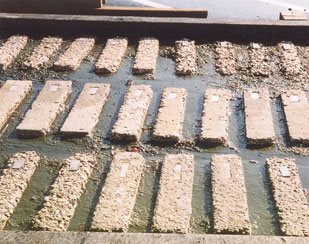- Staining Concrete
- Stamped Concrete
- Concrete Overlays
- Concrete Resurfacing
- Concrete Polishing
- Concrete Dyes
- Colored Concrete
- Indoor Concrete
- Concrete Floors
- Concrete Countertops
- Garage Floor Coatings
- Furniture, Sinks, Fire Bowls
- Basement Floors
- Outdoor Concrete
- Concrete Patios
- Concrete Driveways
- Concrete Pool Decks
- Outdoor Kitchens & Counters
- Outdoor Fireplace
- Concrete Walkways
- Concrete Pavers
- Concrete Walls
- Repair & Maintenance
- Foundation Repair
- Concrete Crack Repair
- Concrete Sealers
- Building with Concrete
- Concrete Homes
- Concrete Basements
- Decorative Concrete
Effects of Substances on Concrete and Guide to Protective Treatments

Aggressive substances can compromise the durability of concrete. Shown are concrete beams exposed to sulfates.(photo courtesy of the Portland Cement Association)
The first line of defense against chemical attack is to use quality concrete with maximum chemical resistance. Added protection can be achieved by applying protective treatments to keep corrosive substances from contacting the concrete or to improve the chemical resistance of the concrete surface.
"Effects of Substances on Concrete and Guide to Protective Treatments" from the PCA addresses both these defenses:
- Components of a chemically resistant concrete mix: suitable cement, aggregates, admixtures, air entrainment and the placing of that mix (finishing, jointing, and curing).
- 23 types of protective surface treatments and the chemicals they help in combating.
A handy chart lists substances by class (acids, oils, salts, solvents, etc.) and the recommended protective treatment.
More information about this document. You can purchase the 36-page booklet or buy a Adobe PDF file and download it right now to your computer.




